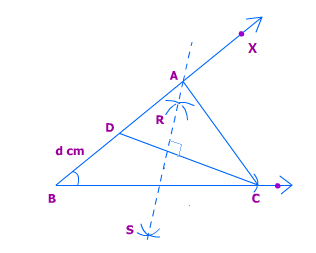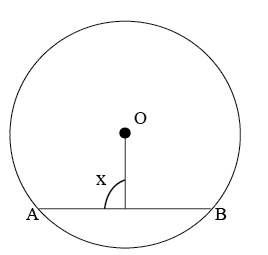9th Grade > Mathematics
CONSTRUCTIONS MCQs
:
B
We know that sum of the length of any two sides of a triangle must be greater than the length of the third side, but the condition in this question defies this law. So the given triangle can not be formed.
A. Draw a line segment, say XY equal to BC + CA + AB.
B. Make ∠ LXY equal to ∠ B and MYX equal to ∠ C.
C. Bisect ∠ LXY and ∠ MYX. Let these bisectors intersect at a point A.
D. Draw perpendicular bisectors PQ of AX and RS of AY.
E. Let PQ intersect XY at B and RS intersect XY at C. Join AB and AC.
:
A
A triangle in which the difference of two sides is lessthan the third side can be made. The steps are as follows:
Step 1 : Draw a line segment BC of length 3.4cm.
Step 2 : Draw an angle of 45∘ from point B.
Step 3 : From Ray BX cut off the line segment BD = 1.5cm.
Step 4 : Join D to C.
Step 5 : Draw bisector of DC.
Step 6 : Extend bisector of DC to intersectthe Ray BX at point A.
Step 7 : Join A to C, Δ ABC is the required triangle.

:
A
An angle bisector divides a given angle into two equal halves. So bisecting a given 80∘ angle will give two 40∘ angles. Hence, the given statement is true.
:
A
A60∘angle can be made by first drawing a line segment AB of any length.
Construct anangle of 60 degrees at both A and B using a compass.
Let the rays intersect each other at P.
The triangle ABP formed is an equilateral triangle. So we can see that the concept behindan equilateral trianglecan be used in constructing a 60∘ angle.
:
A
As OQ is angle bisector of ∠POA, so ∠POQ = ∠QOA= 45∘
:
B
Since two parallel lines do not intersect each other, an angle cannot be formed between them. Thus in this case, angle bisection is not possible.
:
C
A perpendicular bisector can be drawn only if a figure has end points. Only a line segment has a definite length and hence it can be bisected by a perpendicular bisector.
:
B
In the case of a rectangle, the diagonal is not an angle bisector.
Consider a rectangle ABCD.
Here, ∠ ADB = ∠ DBC (Alternate angles)
But, ∠ DBC is not equal to ∠ BDC (Angles opposite to unequal sides of a triangle are unequal)
∴ ∠ ADB is not equal to ∠ BDC
So, diagonal DB does not bisect ∠ D.
:
A

Consider the above figure.
Here, XY is the perpendicular bisector of a line AB.
Let P be any random point on XY.
In △ PMA ≅ △ PMB
AM = BM (Perpendicular bisector divides a line segment into two equal halves)
∠ PMA = ∠ PMB = 90∘
Also PM is common side
So △ PMA ≅ △ PMB (SAS Rule)
∴ PA = PB (CPCT)
Hence, △ PAB is an isosceles triangle.
So, the given statement is true.

















